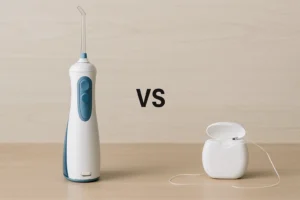
Maintaining optimal oral hygiene is crucial for overall health, and interdental cleaning plays a significant role in preventing dental issues such as cavities and gum disease. While traditional dental floss has been the standard for decades, water flossers have emerged as a popular alternative. This guide explores the differences between these two methods, their effectiveness, benefits, and considerations, supported by scientific research.
Interdental cleaning refers to the removal of plaque and food particles between teeth, areas that toothbrushes often can’t reach. Effective interdental cleaning helps prevent:
Plaque Buildup: Accumulation can lead to cavities and gum disease.
Gingivitis: Inflammation of the gums, which can progress to periodontitis if untreated.
Halitosis: Bad breath caused by food particles and bacteria between teeth.
Overview: Dental floss is a thin cord made of nylon or Teflon designed to slide between teeth, removing debris and plaque.
Advantages:
Effective Plaque Removal: When used correctly, floss can remove up to 80% of plaque between teeth.
Cost-Effective: Floss is inexpensive and widely available.
Portable: Easy to carry and use anywhere.
Disadvantages:
Technique Sensitive: Improper use can lead to ineffective cleaning or gum injury.
Difficult for Some Users: Individuals with limited dexterity or braces may find flossing challenging.
Overview: Water flossers, or oral irrigators, use a pressurized stream of water to remove plaque and debris between teeth and below the gumline.
Advantages:
Ease of Use: Beneficial for individuals with braces, implants, or dexterity issues.
Gum Health: Studies suggest water flossers can reduce gingival bleeding and inflammation.
Comfort: Many users find water flossing more comfortable than traditional flossing.
Disadvantages:
Cost: Higher initial investment compared to traditional floss.
Portability: Less convenient for travel due to size and need for power.
Several studies have compared the effectiveness of water flossers and traditional floss:
Gingival Health: A study published in the Journal of Clinical Dentistry found that water flossers were 29% more effective than traditional floss in reducing gingival bleeding and 26% more effective in reducing plaque.
Plaque Removal: Research indicates that while both methods are effective, water flossers may offer superior plaque reduction in certain populations, such as those with orthodontic appliances.
User Compliance: Ease of use with water flossers may lead to better compliance, enhancing overall oral health outcomes.
Choosing between a water flosser and traditional floss depends on individual needs:
Traditional Floss: Suitable for individuals without dental appliances and who can effectively use floss.
Water Flosser: Ideal for those with braces, implants, or dexterity challenges.
Regardless of the method, consistency is key. Daily interdental cleaning, combined with regular brushing and dental check-ups, is essential for maintaining oral health.
Both water flossers and traditional dental floss are effective methods for maintaining oral hygiene, and the right choice depends on your individual needs, comfort, and lifestyle. Water flossers may offer better ease of use and gum health benefits for certain individuals, especially those with braces, implants, or dexterity challenges. Traditional floss, when used correctly, remains a reliable and affordable tool for interdental cleaning.
Regardless of the method you choose, daily interdental cleaning is essential to prevent plaque buildup, gum disease, and bad breath.
🦷 Need help finding the best routine for your smile?
At ArtSmiles, we offer personalised dental care plans tailored to your needs. Whether you’re due for a check-up or want guidance on your home care routine, we’re here to support your oral health.
📞 Call us today or
📅 Book your appointment online and take the next step toward a healthier smile.
Note: The information provided is based on current scientific literature and is intended for educational purposes. Always consult with a dental professional for personalized advice.
Barnes, C. M., Russell, C. M., Reinhardt, R. A., Payne, J. B., & Lyle, D. M. (2005). Comparison of irrigation to floss as an adjunct to tooth brushing: Effect on bleeding, gingivitis, and supragingival plaque. Journal of Clinical Dentistry, 16(3), 71–77.
Rosema, M. A. M., Hennequin-Hoenderdos, N. L., Berchier, C. E., Slot, D. E., van Palenstein Helderman, W. H., & van der Weijden, G. A. (2011). The effect of different interdental cleaning devices on gingival bleeding. Journal of the International Academy of Periodontology, 13(1), 2–10.
Lyle, D. M., Gellin, R. G., & Kingman, A. (2001). The effect of a dental water jet with orthodontic tip on plaque and bleeding in adolescent orthodontic patients. American Journal of Orthodontics and Dentofacial Orthopedics, 119(2), 123–131. https://doi.org/10.1067/mod.2001.111997
Cobb, C. M. (2008). Microbes, inflammation, scaling and root planing, and the periodontal condition. Journal of Dental Hygiene, 82(suppl), 4–9.
Gates, R. H., & Niessen, L. C. (2014). Water flosser versus traditional floss: Effectiveness and ease of use. Compendium of Continuing Education in Dentistry, 35(3), 192–198.
Sharma, N. C., Lyle, D. M., Qaqish, J. G., & Galustians, J. G. (2008). Effect of a dental water jet with orthodontic tip on plaque and bleeding in adolescent orthodontic patients with fixed appliances. American Journal of Orthodontics and Dentofacial Orthopedics, 133(4), 565–571. https://doi.org/10.1016/j.ajodo.2006.04.039
van der Weijden, G. A., Slot, D. E., & Rosema, M. (2019). Clinical efficacy of mechanical plaque control in managing gingivitis: A meta-review. Journal of Clinical Periodontology, 46(Suppl 21), 92–105. https://doi.org/10.1111/jcpe.13077